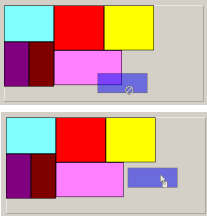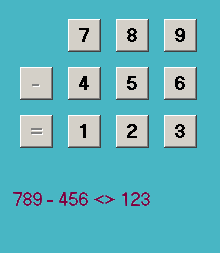What's New - April, 2006
[Home]

April 30, 2006: We'll squeeze one more program in this month. Spring duties like garden preparation, clearing some stumps and brush from under the power lines, and getting back to the woodworking shop have slowed "production", but it does seem good to get outside with decent temperatures. Here's a Drag/Drop Image Demo program written to solve a sub-problem of an upcoming "human intelligence" version of our Cutlist program. The idea is to let users drag and drop images of required parts onto available supply piece images for woodworking projects. The current Cutlist version searches for good ways to accomplish the task by trial and error with some success. But there are cases where the program it is not smart enough to produce the best result. The new version will let the user take a crack at finding a satisfactory layout. This demo, posted in the Delphi-Techniques section, just addresses the mechanics of dragging and dropping images from one scrollable list (required pieces) to another scrollable list (of available supply pieces).

April 13, 2006: The problem of covering a given set set of points with the smallest possible circle is interesting. I published a program to solve it several years ago. A viewer wrote today with a question about applying the best algorithm for solving the problem (not mine, but one used in the program) for a collinear set of points. The algorithm handles the case but my program didn't like my code to scale collinear data for plotting. Version 2.1 of the Circle Covering Points program was posted today which fixes that problem and makes a number of other enhancements for the way that test data is entered and saved.
April 9, 2006:

The young math professor noticed one day that this subset of his calculator's keys could be read as an equation, but not a valid one. However, by exchanging a couple of pairs of numeric keys he could make the equation valid. Can you find the 2 pairs of keys that he swapped? Here's another puzzle adapted from the Giant Book of Mensa Mind Challenges book. and posted today as the Calculator Keys Puzzle
.
April 4, 2006: My learning curve has steepened this week as I tackle two new ventures. I'm installing my first Windows Server (2003) at home as I write this (lots of wait time in the process). No real good reason for the install except to make files and email more accessible from any of the four computers scattered around the house. So far so good.
The other new experience will be to fool around
with Delphi for .Net, the version that natively knows about online
coding. If you live in the USA and are a student,
have a student, or are otherwise associated with an
educational institution, the academic version of Borland
Developer Studio 2006 Professional is available for under $100.
A heck of a bargain! It
includes two Delphi compilers (Win32 and Delphi.Net) as well as
C++ Builder and C# Builder compilers. Granddaughter Kaitlin
recently acquired a copy (as a "gift" which she has kindly
let me check out first :>). I'm about 80 pages into the
best current Delphi book:
Mastering Delphi 2005, Marco Cantu He has a good
understanding of the material and a very readable first person
writing style that has kept him at the top of the Delphi authors
club for years. His website has the Delphi 2006 update and
chapter by chapter source code for all of the examples in the
book.
On the more mundane side, I've been doing some housekeeping, and decided it was time for a new version of the DLL Library (DFFLibV06). For information about the idea and motivation for a common library file, click here.
Changes are:
-
The UBigFloatV2 large floating point arithmetic unit has been moved to the library.
-
The BigfFloat test program has been relocated and has an additional test added for the "Compare" operation.
-
UParser10, an arithmetic expression parser/evaluator used in a couple of calculator programs was moved to the library.
-
UBigIntsV2 has new FastMult and FastSquare procedures written by regular contributor, Charles Doumar, for very large integers. About 2 ½ times faster than Mult or Square for 100,000 digit numbers. (1.4 seconds vs. 3.5 seconds on my laptop).. 12 times faster for 250,000 digits. I reposted the BigIntsTest program with an added button to time the results for random integers of specified size.
-
A new "FreeAndClear" procedure was added to the DFFUtils unit. It will release any objects associated with string lists in TStringList, TMemo, or TListBox controls as well as delete the string items. Objects in string lists are a nice feature, but the standard Clear method does not free the objects (with good reason, you may not want the objects released if they are used elsewhere). On the other hand, not freeing objects when you are finished with them can lead to a major memory leak and freeing them requires writing code to loop through each entry. FreeAndClear solves this for you.
If you find any Type 1 (commission) or Type 2 (omission) errors in all of this, let me know.
April 2, 2006: Most every year, a student or two uses our ReactionTimes program as part of some project and writes for help or to report a bug. This year a bright high school junior is testing aural vs. visual response times as his Advanced Biology project. I posted a version today that adds sounds to the trial type choices. Good luck, Brad.
